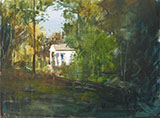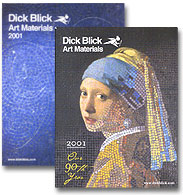How to paint trees in a landscape
When I was in grammar school, I painted trees with green leaves and black or brown trunks and limbs. Back then, life was simple.
Years later, I learned two things:
- leaves are not necessarily green
- tree bark is rarely black or brown
Rule 1: Don't paint individual leaves
Tree foliage should be painted in masses and clumps that represent all those individual leaves. It's so much easier and it looks so much better, as shown in A Place in the Sun.

By the way, some of the tree trunks on the right side of this painting are light because they're against a dark background (See The sidebar and rule 4.)
Clump shapes: If you look at a tree from a distance you'll see massed shapes. The shapes vary from species to species. Concentrate on the geometry of the shapes and then paint them accordingly—round, triangular, boxy, or completely irregular.

Tree shape: Make sure you fit all of these clumps into the basic overall shape of the tree—conical, round, elliptical, or whatever, as shown in San Juan Island Trees. Note that the foliage has lots of blue, as discussed in Rule 2.
Rule 2: Don't paint green foliage
OK, OK. You can paint it a little bit green, with hints of green, and with variations of green, but it's best to use neutrals unless you're doing a botanical illustration or trying to match the living-room sofa.
Trees are usually background material in a landscape, as seen here in Walking in the Rain. Keep them there!

Rule 3: Don't go out on a limb
Pay attention to the size and direction of the limbs. In general, the limbs get shorter and thinner as they get higher on the tree.
Also, lower limbs are generally more nearly horizontal and higher limbs are more nearly vertical. Go outside and look at a few trees and you will see that I speak the truth.
Don't paint limbs directly opposite one another on the trunk. Move them up or down as necessary.
Rule 4: Bark isn't always dark
Don't use plain old black or brown for the tree's bark. Go for interesting darks and lights of the proper value. It will work just fine, and it will be more exciting.
In Billy's Barn, you see some light tree trunks and very little in the way of defined limbs. We're looking at the barn and the sign, doggone it! The trees and limbs are background (Remember rule 2.).

And here's the big secret. On any given tree, the value of the bark will change drastically with the change in light and background. See the sidebar for proof.
copyright James H. Stephens
All rights reserved



